It was 100 degrees outside. Since we had already walked 36 holes in the past 22 hours, we agreed that a change of pace was in order. We decided to try some time travel.
We were at Prairie Dunes Country Club in Hutchinson, Kansas. Both that morning and the previous evening, we had played 18-hole rounds. All the while, in the distance, there was a low, continual din of shouting and splashing. The heat had driven a crowd of local kids to the club pool. At times, sweating in my hat and collared shirt, I almost envied them. Almost, I say, because the golf was so good.
Perry Maxwell, the great Oklahoma-based architect, built the first nine holes at Prairie Dunes in 1937. Twenty years later, his son Press completed the course, but he didn’t simply build the new nine on a separate piece of land. Rather, he added three holes to the west side of the clubhouse and six to the east. In doing so, he followed his father’s plans, though there is some doubt as to how faithful he was.
Today, the old version of Prairie Dunes—consisting of Nos. 1, 2, 6, 7, 8, 9, 10, 17, and 18—sits embedded within the modern one. A few of these holes are not only the best on the course but among the finest anywhere. Our time-traveling notion on that hot afternoon was simple: to play Perry Maxwell’s original nine.
Minimalism—by necessity and preference
The less of man’s handiwork the better a course. – Perry Maxwell
Like Southern Hills, Perry Maxwell’s tour de force of championship golf in Tulsa, Prairie Dunes was a product of the Great Depression. Maxwell drew up 18 holes, but he ended up building only nine. The construction itself, headed by his brother-in-law Dean Woods, was a model of thrift. They hired men through the Works Progress Administration, used rudimentary equipment, and moved a bare minimum of earth.
This approach happened to suit Maxwell just fine, as he believed in low-cost minimalism with a kind of evangelistic zeal. Speaking to The American Golfer in 1935, he said, “It is my theory that nature must precede the architect, in the laying out of links. It is futile to attempt the transformation of wholly inadequate acres into an adequate course. Invariably the result is the inauguration of an earthquake. The site of a golf course should be there, not brought there. Many an acre of magnificent land has been utterly destroyed by the steam shovel, throwing up its billows on earth, biting out traps and bunkers, transposing landmarks that are contemporaries of Genesis.”
These convictions of Maxwell’s were as much financial as they were aesthetic. His trips to Great Britain persuaded him that American golf was mired in unsustainable addictions. As he put it his American Golfer interview, “[T]he majority of American golf clubs are in the red, gore of the steam shovel, blood drawn by the mound-builders. We have learned nothing from Scotland or England where the ancient and honorable game can be enjoyed on marvelous links at one tenth the admission fees, dues, green fees, etc., that prevail in the land of the free.”
Maxwell’s spartan methods were well suited to tough times, and in the 1930s, when many other golf architects stopped working, he continued to design and build courses.
In 1935, Maxwell met with the Carey family about building a course on the outskirts of Hutchinson, Kansas. Depending on which historical account you believe, either Maxwell spotted or the Careys showed him a stunning tract of Ice Age-forged dunesland east of town. Beneath the wild grasses, yucca, sandhill plum, and cottonwood trees, he must have recognized the undulations, large and small, that would make for compelling golf.
-
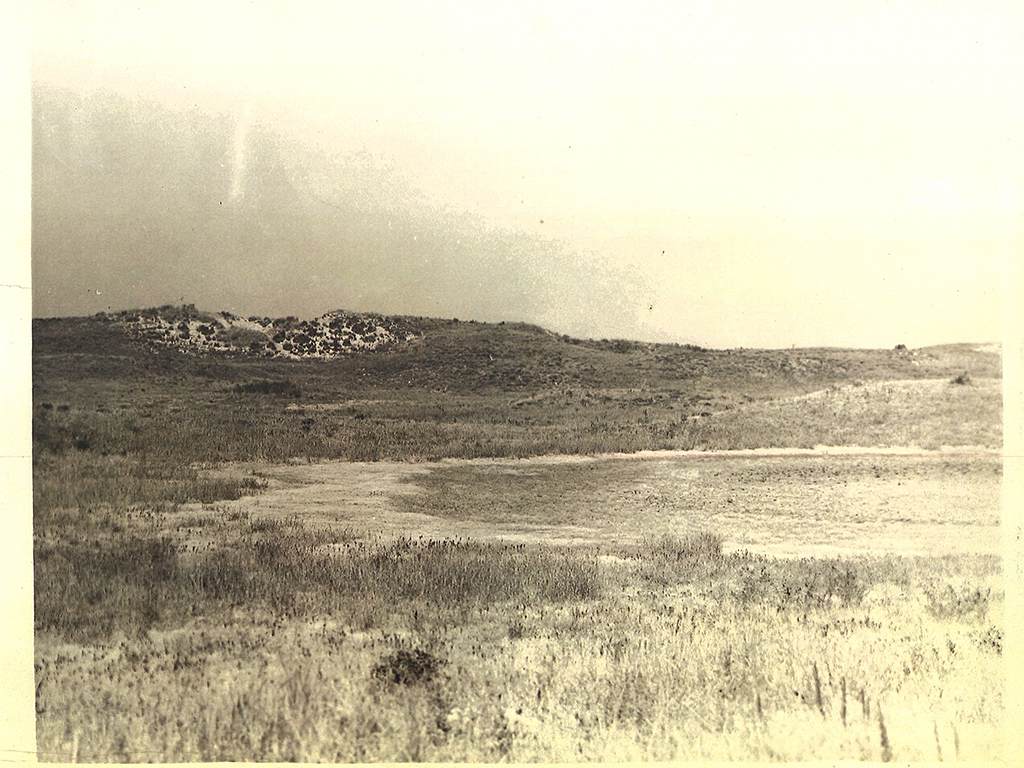
The Prairie Dunes site before the construction of the course
-
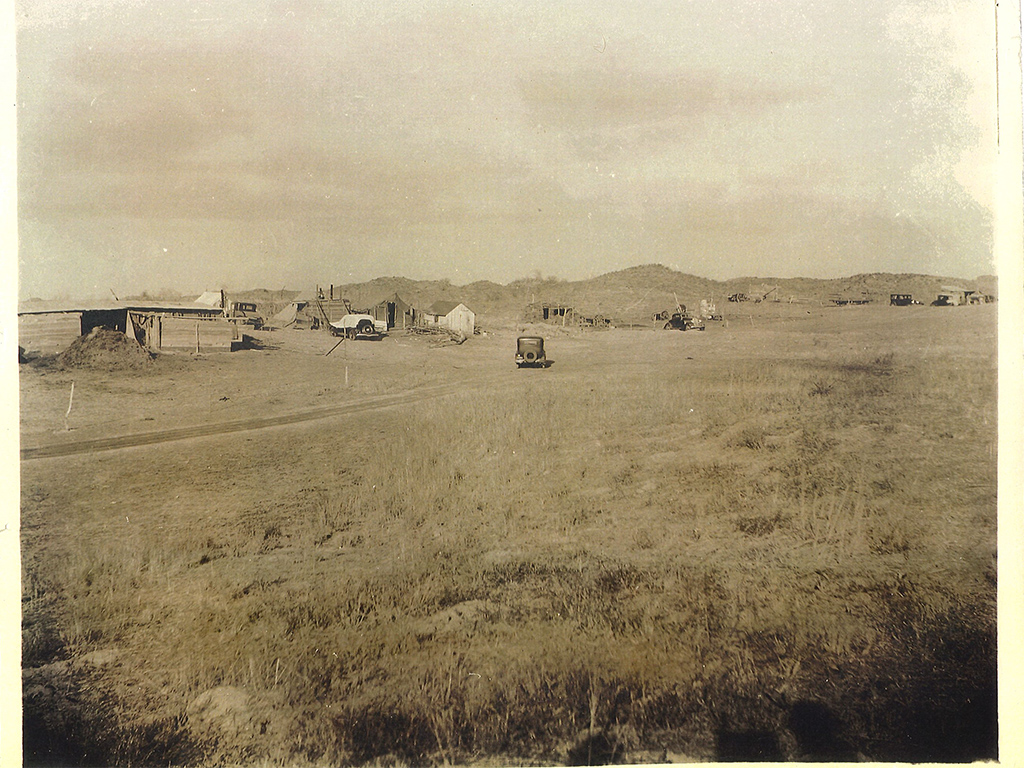
The Prairie Dunes site during the construction of the course
Since Maxwell preferred not to design from maps, he spent a month simply walking the property. “You see,” his son Press said, “he had so much ground to work with that he wanted to see it all, and from all directions. He didn’t design courses from maps. He went out in the field because he wanted to be right in the place where the game was to be played.” It was around this time that Maxwell delivered his most reprinted line: “There are 118 holes here, and all I have to do is eliminate 100.”
The construction methods were rustic. Under the supervision of Dean Woods, whom Press referred to as “an old fellow who was opposed to the use of tractors,” the WPA crew built Prairie Dunes quickly and cheaply in the first half of 1937. As Mal Elliott writes in his book Perry Maxwell’s Prairie Dunes, “The construction of the course was done with teams of horses and mules, 18 in all, and slips and Fresno scrapers and wheelbarrows. There was not one piece of mechanized equipment except for the Model T and Model A Fords and trucks which took the workers to the site. The greens and fairways were cleared and scraped by teams dragging plows and scoops. The roots of native grass and weeds were all removed by hand, one wheelbarrowful at a time.”
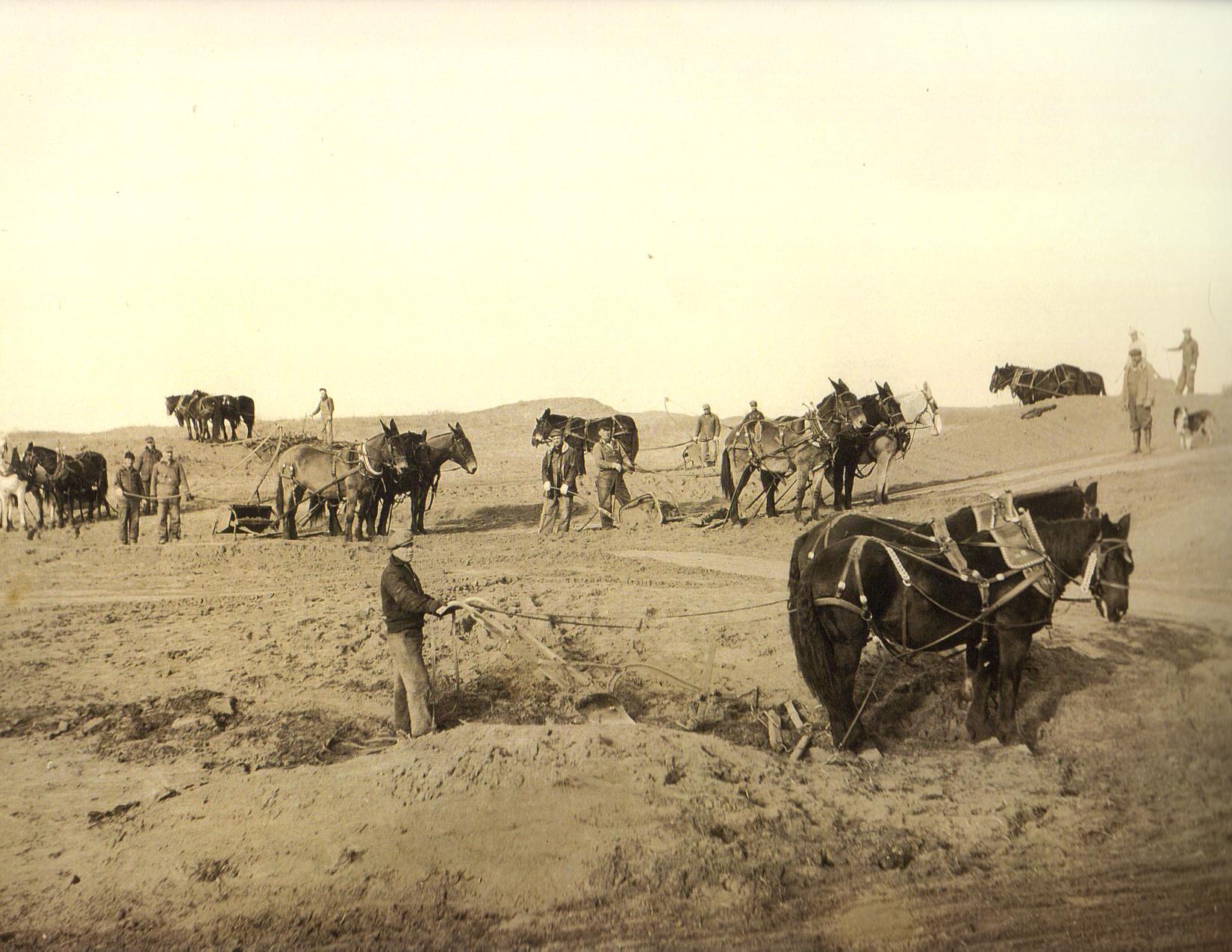
Using simple methods at the Prairie Dunes construction site
The result was a course that, to this day, meshes humbly yet artfully with the landscape. The transitions between the manmade and the natural—the “tie-ins,” as modern architects call them—are nearly imperceptible. When Perry’s nine opened in September 1937, knowledgeable golfers, including Walker Cupper Johnny Dawson, saw it for what it was: the best nine-hole course in America.
(For the historical narrative above, I relied on three books: Mal Elliott’s Perry Maxwell’s Prairie Dunes; Christopher Clouser’s The Midwest Associate; and Anthony Pioppi’s To the Nines. All are excellent reads.)
-
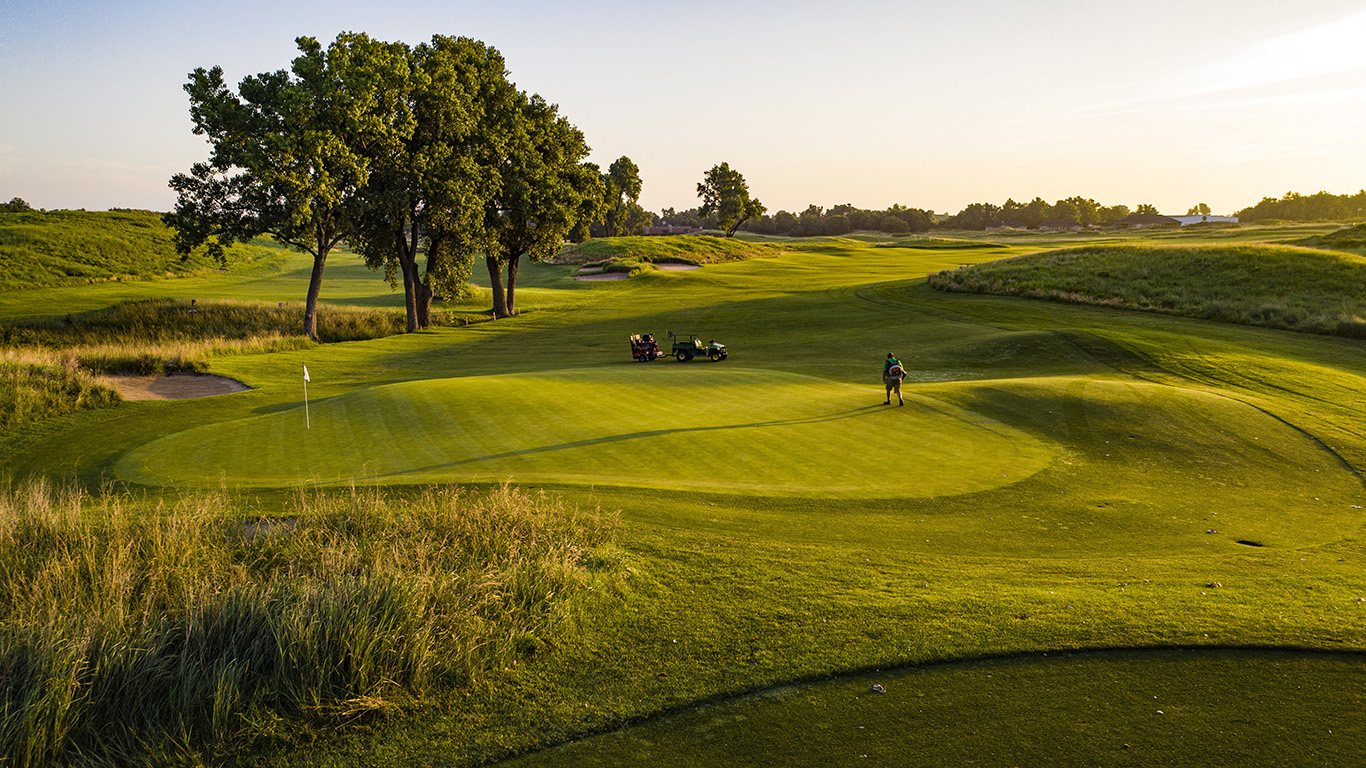
No. 1 at Prairie Dunes
-
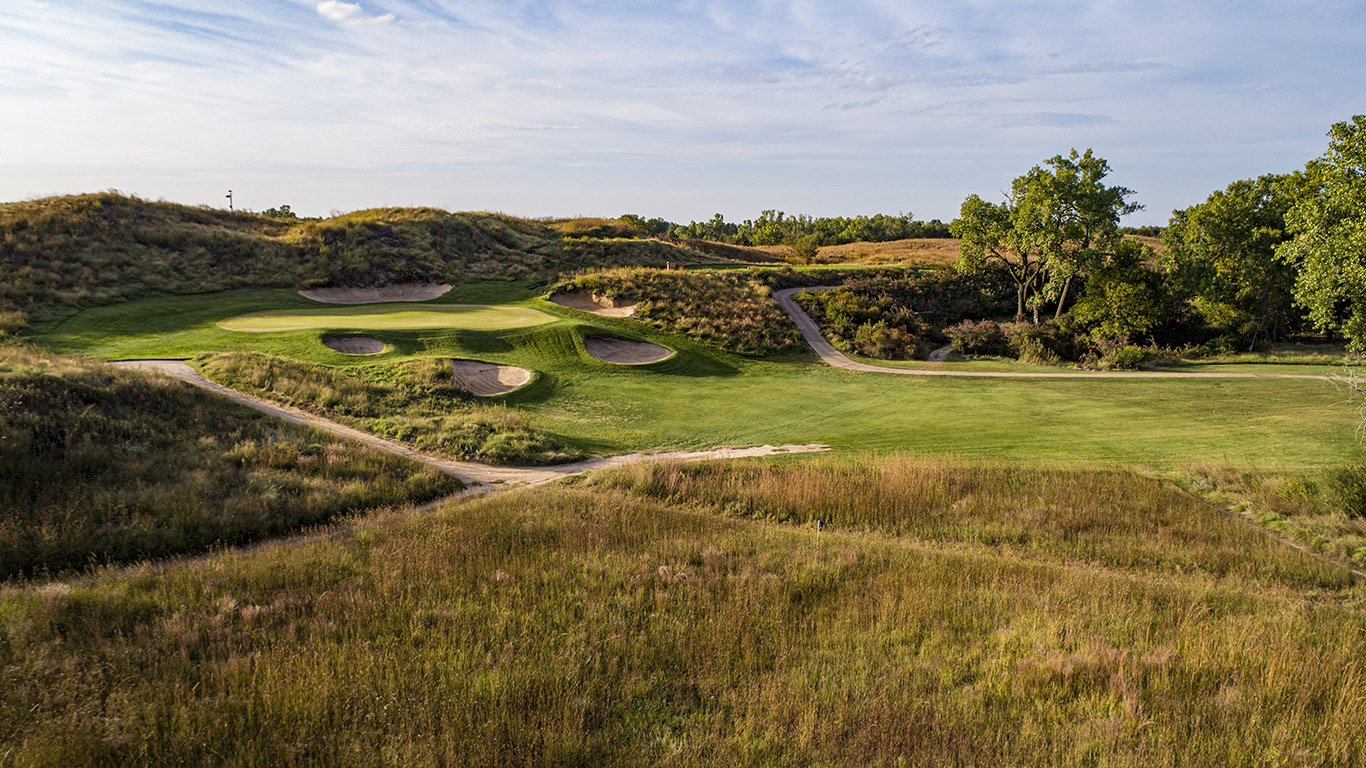
No. 2 at Prairie Dunes
-
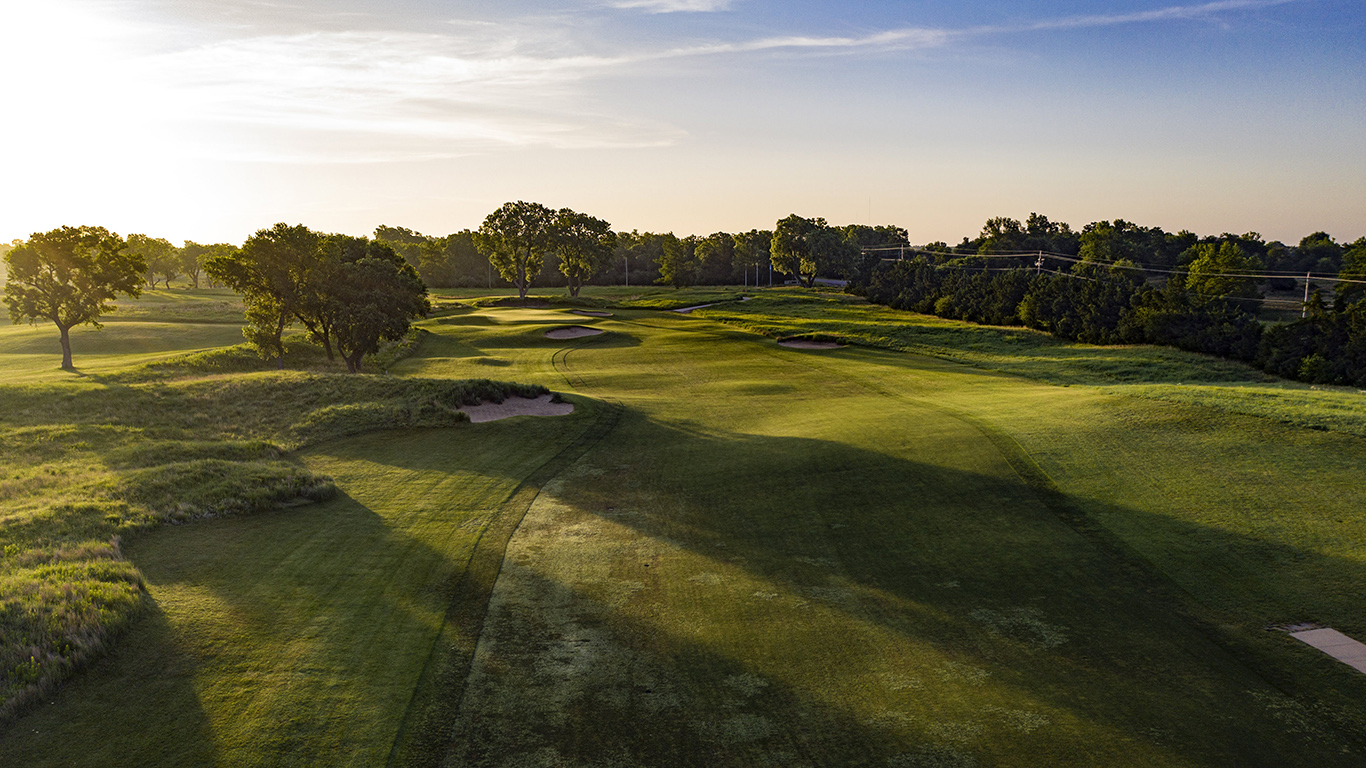
No. 6 (old 3) at Prairie Dunes
-
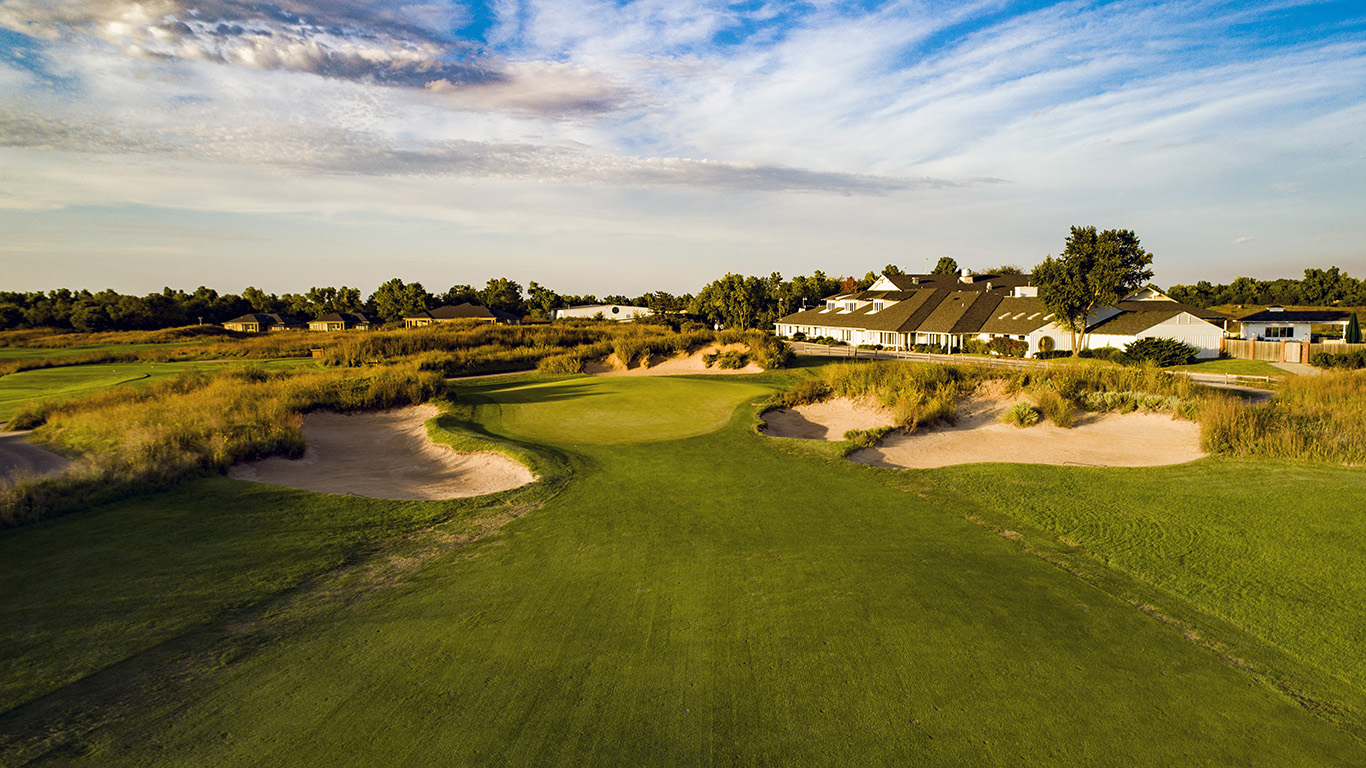
No. 7 (old 4) at Prairie Dunes
-
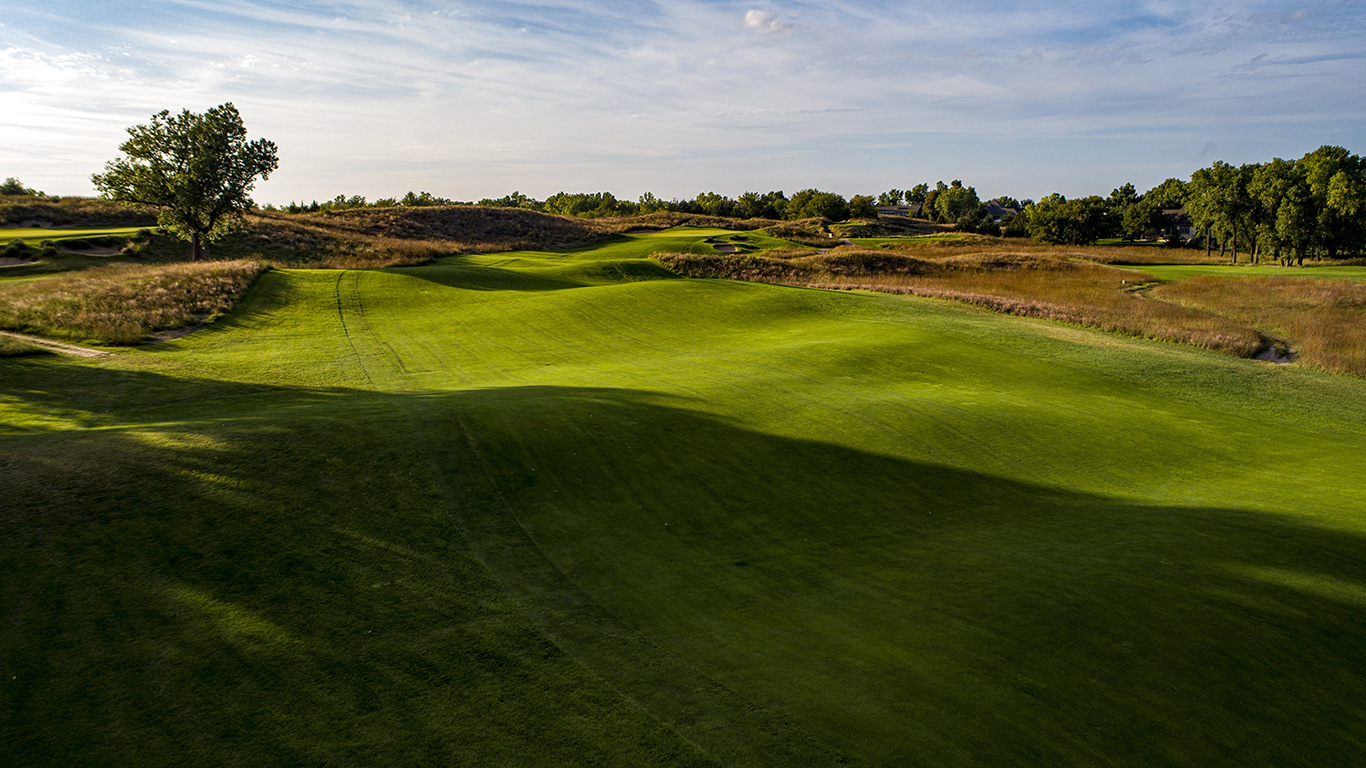
No. 8 (old 5) at Prairie Dunes
-
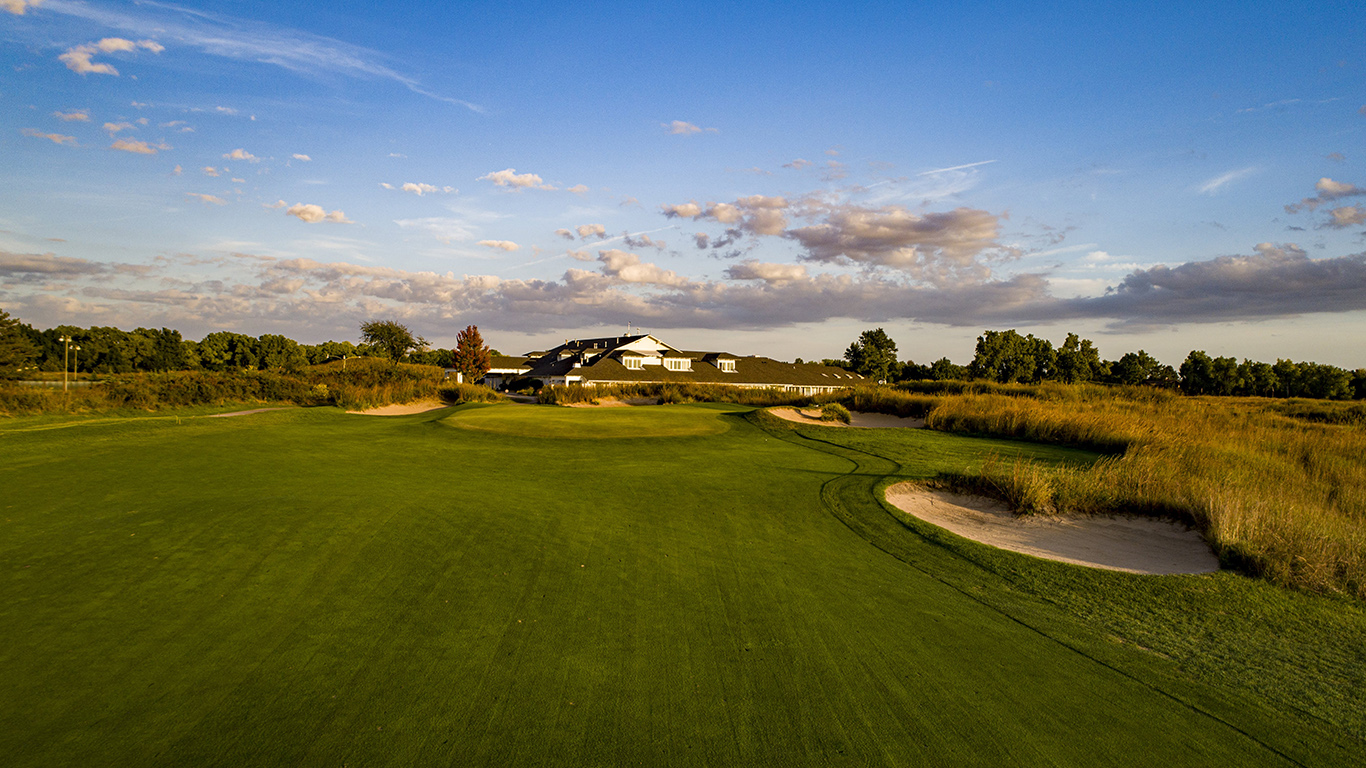
No. 9 (old 6) at Prairie Dunes
-
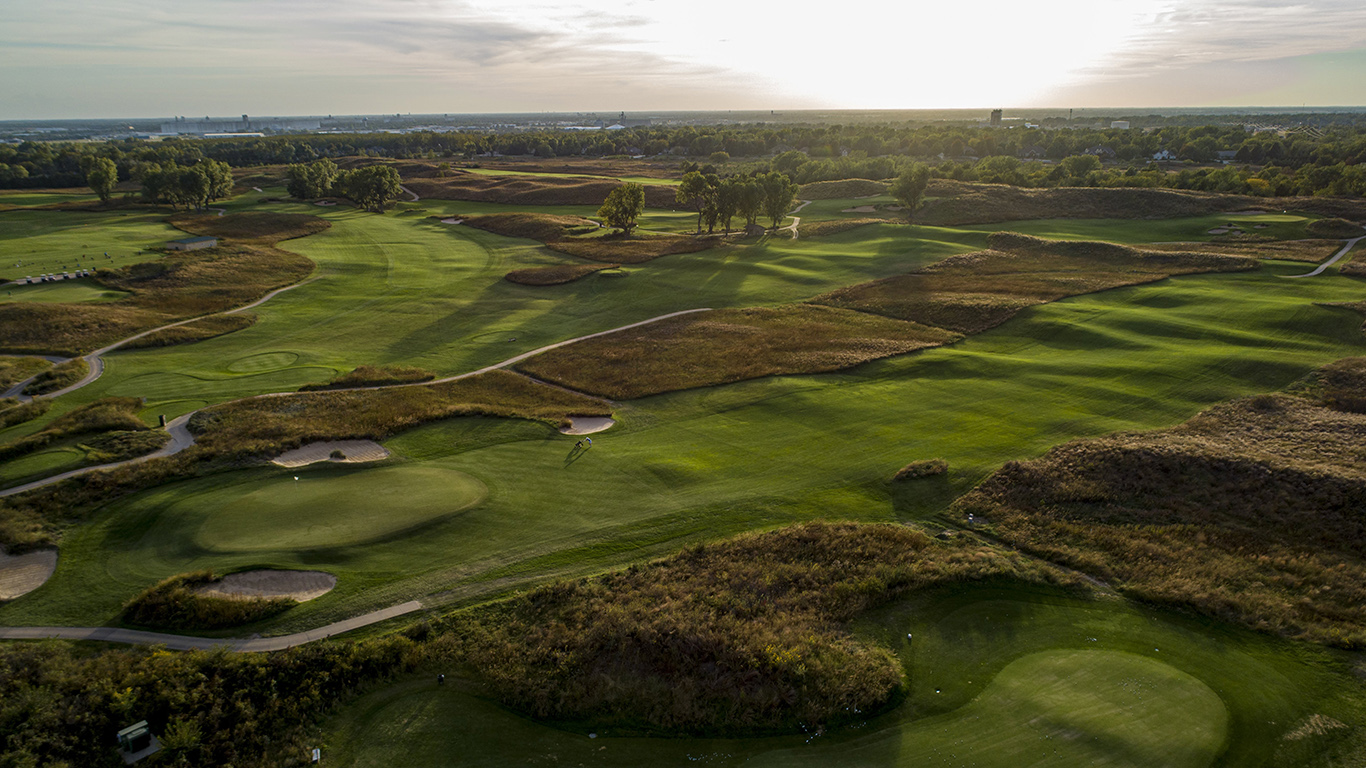
Nos. 1, 8, and 9 at Prairie Dunes
-
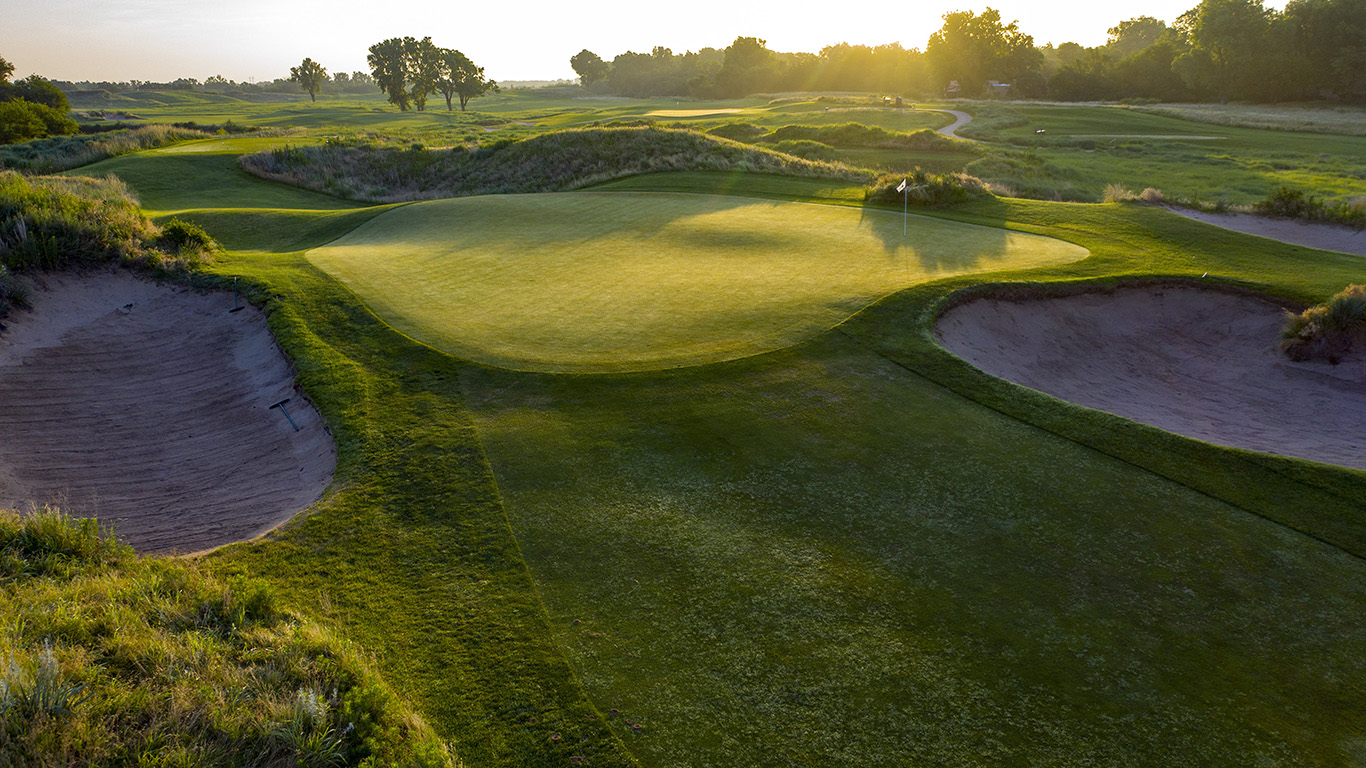
No. 10 (old 7) at Prairie Dunes
-
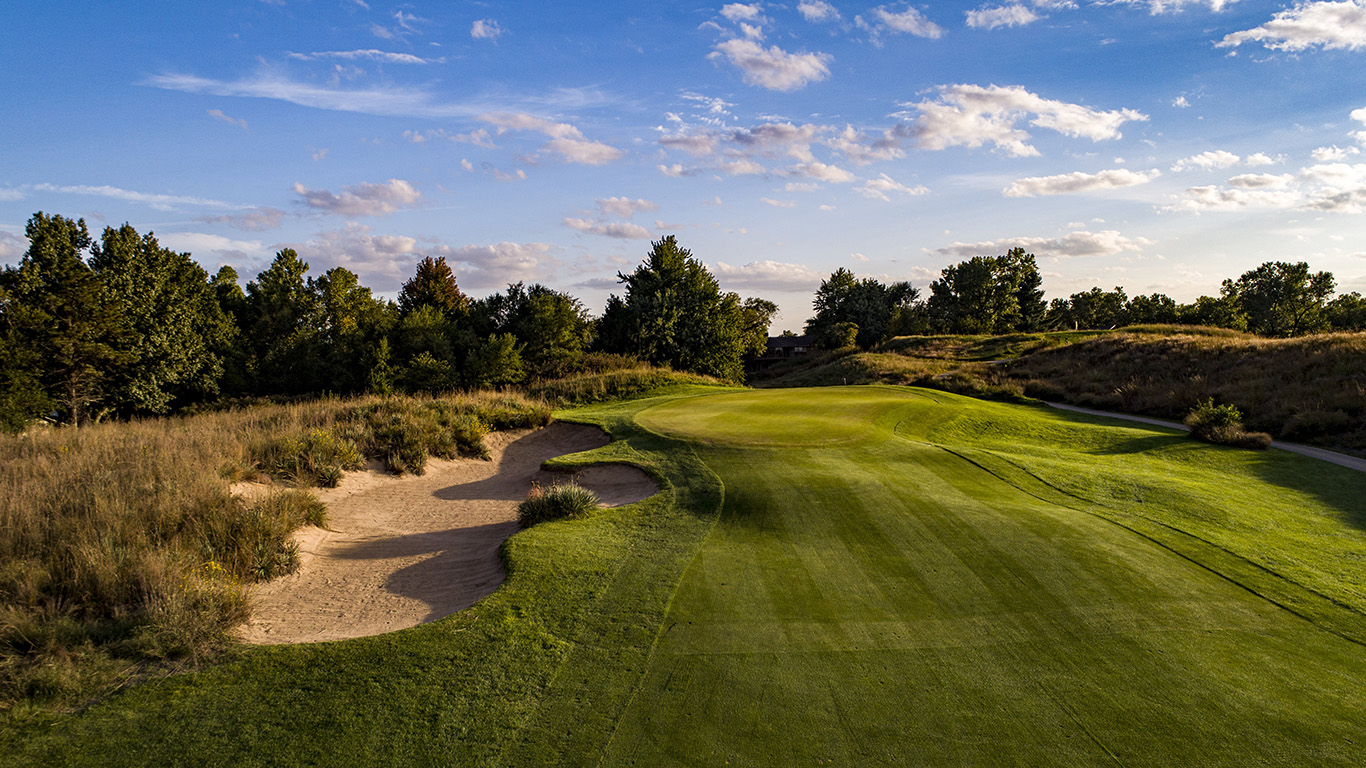
No. 17 (old 8) at Prairie Dunes
-
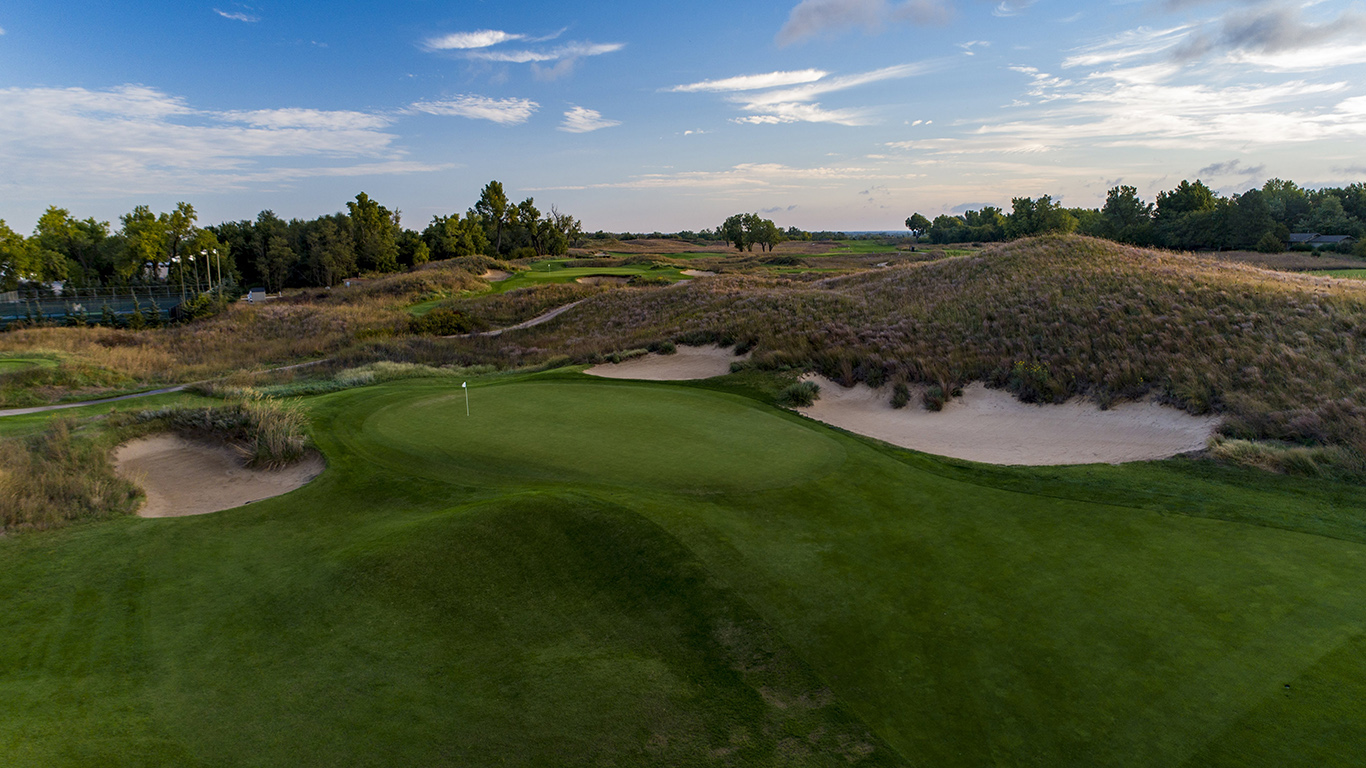
No. 18 (old 9) at Prairie Dunes
-

Nos. 17, 18, and 10 at Prairie Dunes
Perry’s nine
When we set out to rediscover Perry’s nine that afternoon in late June, we knew we weren’t the first. Anthony Pioppi, for one, had played the original course in preparation for his book To the Nines. Also, the members of Prairie Dunes Country Club are well aware of the distinction between the “Perry holes” and the “Press holes,” and I’m sure many of them have taken a crack at the old nine.
Nor did we intend our experiment as a slight to Press Maxwell’s work. While the Perry holes are generally better (“Press did not have the imagination and vision his father had,” Jake Carey told Pioppi), the Press holes would be standouts anywhere else. A few of them, especially the slanting, tempting par-4 14th, are among my favorites on the course.
Still, as we discovered, there is a special rhythm and coherence to Perry’s nine that you can appreciate only by playing it in its 1937 sequence.
Hole No. 1
- 1937: par 4, 415 yards
- Today: par 4, 452 yards
The tough opening hole swings to the left, into the prevailing wind, daring you to cut the corner to get a shorter approach. The real fun starts at the green. From the 1930s to the present day, golf writers have spoken of “Maxwell’s rolls,” and this green is a good example of why. Here, instead of simple tiers, you see ripples that rise to a point and fall away. This style of contouring raises the stakes of the shots played into, around, and on the green: if your ball finds the correct side of a “roll,” it will collect toward the pin; if it doesn’t, it will swerve away.
Hole No. 2
- 1937: par 3, 140 yards
- Today: par 3, 164 yards
Benched into the property’s main ridge of dunes, the 2nd is an imposing target, even if it sits only 140 (or from today’s back tees, 164) yards away. The green points to about 10 o’clock, asking for a left-to-right shot shape. The wind, however, tends to push the ball to the right, toward a back bunker where, I can assure you, you do not want to be.
After finishing on the 2nd green, we made our first deviation from the modern routing of the course. Instead of hiking up to today’s 3rd tee, we took a path to the left, through the “gunsch.” It was a stirring walk.
Walking from the 2nd green at Prairie Dunes to what used to be the 3rd tee when the course was a nine-holer. The transition is still there. pic.twitter.com/6tBhsrGTpp
— Garrett Morrison (@gfordgolf) June 30, 2019
Hole No. 6 (formerly No. 3)
- 1937: par 4, 335 yards
- Today: par 4, 387 yards
Right away, we saw that the forward tee of the 6th hole must have been the main tee of the original 3rd. From there, the hole unfurls around a big bunker on the left. Beyond this intimidating hazard, there is an area of maintained rough from which a sightline opens to the left portion of the crowned green. A fairway bunker on the right guards the other decent look at various pins. From the middle of the fairway, your view is obstructed by a flashed bunker that appears to abut the putting surface but is in fact 13 yards short.
The current 6th is one of several holes at Prairie Dunes that would benefit from fairway expansion. Pushing the mowing lines to the outer edges of both fairway bunkers would bring the best, riskiest options back into play.
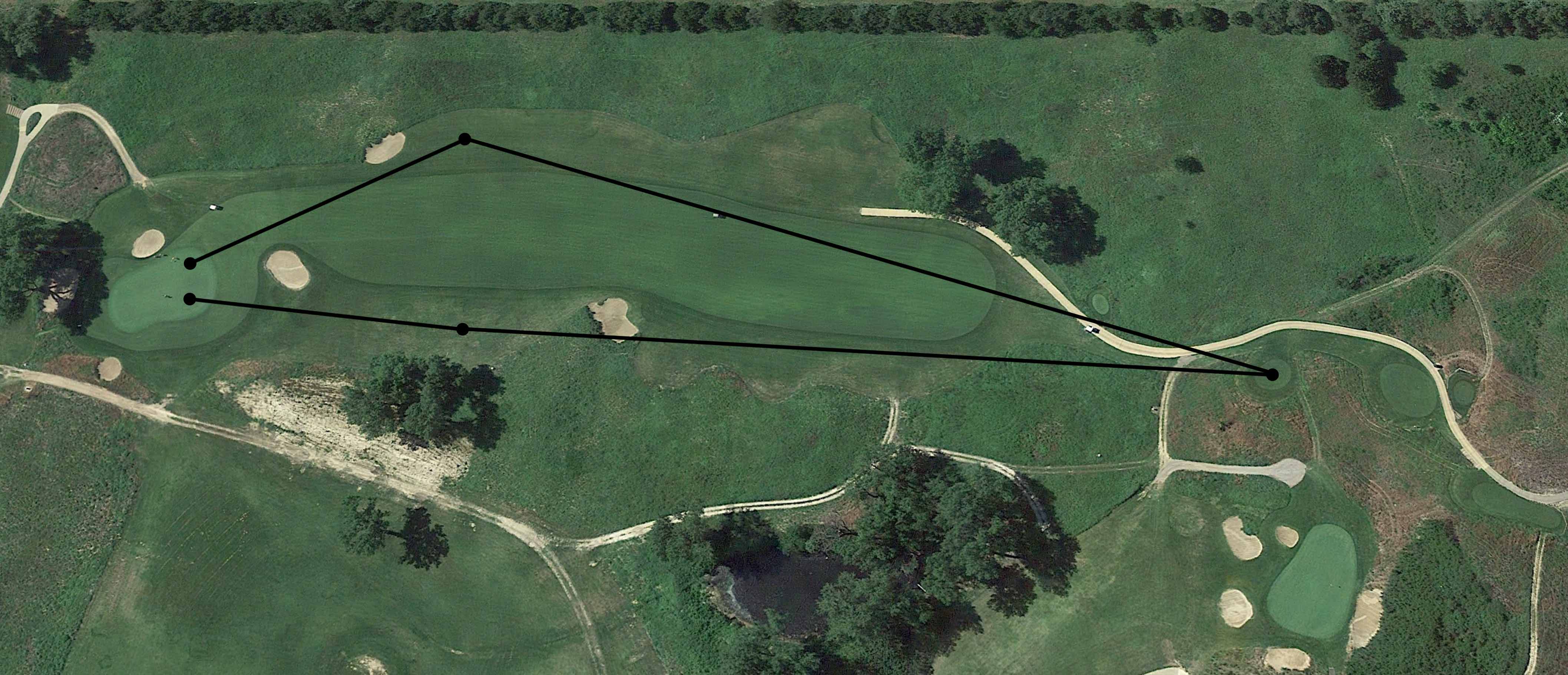
Advantageous angles from the rough on the 6th hole at Prairie Dunes. Note also the modern back tee (bottom right) and the path to the forward tee from the 2nd green. (Google Earth)
On other holes, especially today’s Nos. 9, 17, and 18, rough has encroached on safe but less strategically desirable sides of the playing corridors. In those places, the longer grass is unnecessary; the poor angles should be the main penalty. Unlikely as it seems, then, Prairie Dunes, one of the greatest courses anywhere, could be even better.
From the 6th green, we walked straight back to another original tee that now serves as a forward tee. It’s a peaceful spot. A pair of cottonwood trees provide shade, encouraging a moment of reflection.
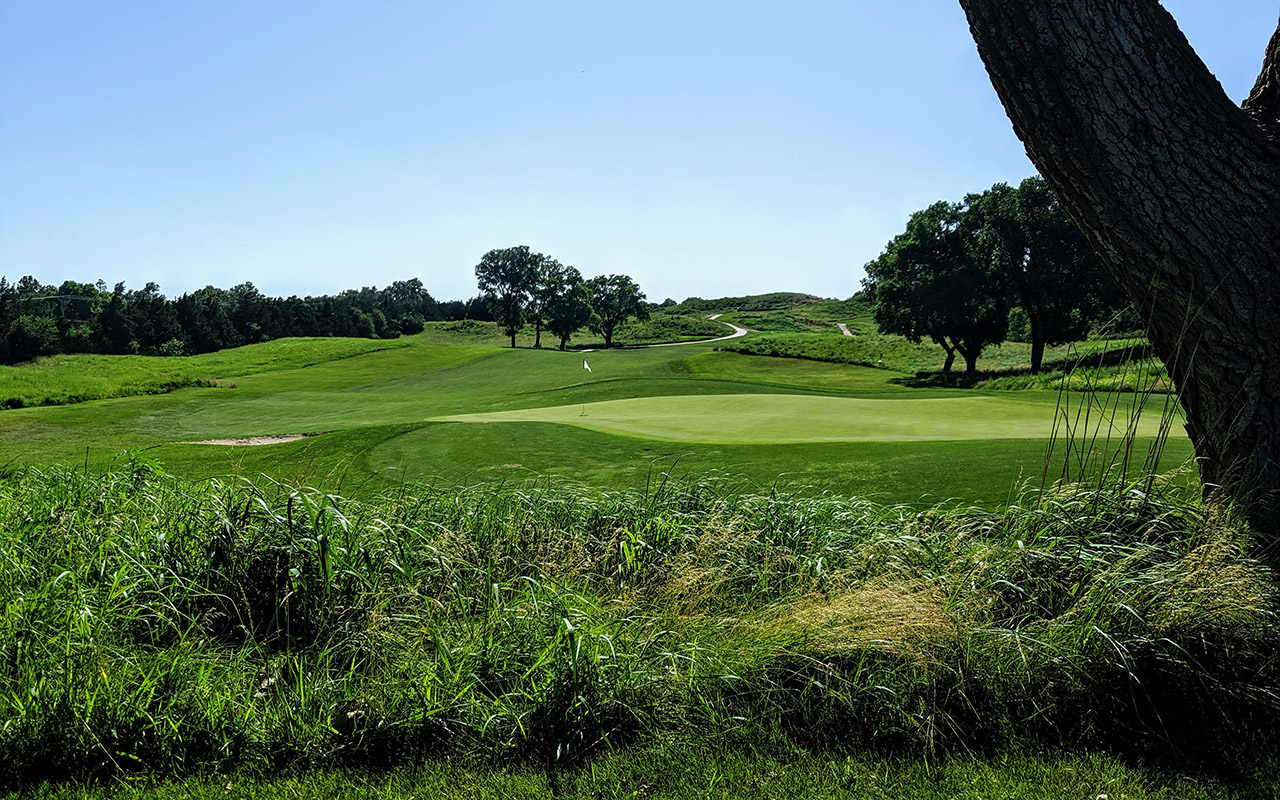
The 6th (formerly 3rd) hole from what used to be the 4th tee
Hole No. 7 (formerly No. 4)
- 1937: par 4, 440 yards
- Today: par 5, 512 yards
The 7th hole is now a short par 5, but Maxwell designed it as a long par 4. Once you find the fairway, you can either lay up to a generous area short of the green-side bunkers or trust your downwind approach to hold a green surrounded by treacheries of undulation, sand, and shrubbery.
Hole No. 8 (formerly No. 5)
- 1937: par 4, 395 yards
- Today: par 4, 468 yards
The best known hole at Prairie Dunes tumbles over some of the most impressive terrain on the property—huge, lurching waves of land. The usual left-to-right wind diverts tee shots toward a stretch of gunsch where, if you find your ball, you will have no view of the green and no real hope of hitting it. Only with a powerful drive will you avoid a blind second shot. Even then, you will likely be hitting from an awkward lie to a severely canted green perched high in the sand hills.
This is golf as pure adventure.
Hole No. 9 (formerly No. 6)
- 1937: par 4, 400 yards
- Today: par 4, 452 yards
If the 8th hole shows off the Hutchinson dunesland at its most dramatic, the 9th emphasizes its subtler contours. A closely mown swale to the left of the green influences tactics all the way back to the tee. To be able to aim your approach away from this hollow instead of toward it, your tee shot has to ride the wind to the left side of the fairway without sailing into a large, gnarly bunker. The more you hedge away from this hazard, the worse the angle of your second shot becomes. Complicating matters, toward the safe, right side of the fairway, the undulations grow bigger, increasing the likelihood of a lie that will conspire with the wind to force your approach left, toward that green-side basin.
Hole No. 10 (formerly No. 7)
- 1937: par 3, 160 yards
- Today: par 3, 185 yards
Like the 7th hole, the 10th runs with the prevailing wind. And as on the 7th, Maxwell tests your ability to hold the green by placing bunkers short. When the pin is on the right, you have two options: 1) drop a downwind mid-iron just past the bunker on the right and somehow keep it from running through, or 2) go left and accept the inevitability of a triple-breaking, 60-foot lag putt.
When I think of a prototypical scalloped Maxwell green, this one comes to mind. From the devilish hummock center-right, to the merciful central channel, to the repelling edges front left and back left, every section makes for delightful chipping and putting.
Hole No. 17 (formerly No. 8)
- 1937: par 5, 510 yards
- Today: par 5, 523 yards
Here is where our time travel briefly failed: Maxwell’s original tee was just behind the 10th green, and the tee shot played diagonally across the dune ridge between Nos. 17 and 18. There was visible room to the left, but position A was to the right of the hog’s back in the fairway, blind from the tee and close to death in the prairie grass. From there, you had a chance to go for the narrow, elevated green, guarded by bunkers left and a drop-off right.
We were unable to hit from the original teeing ground, however. In expanding the course to 18 holes, Press moved the 17th tee to the east. Now it is a straightaway hole—still excellent, but not as fun.
Hole No. 18 (formerly No. 9)
- 1937: par 4, 370 yards
- Today: par 4, 390 yards
While relatively short, this finishing hole, Perry’s 9th, is a culminating trial of nerve. As on the No. 17, the garden spot is on the right, but a strong right-to-left slope makes it hard to hit. Also, since this section of the fairway is concealed form the tee, and since the wind presses scarily toward the dunes on the right, a bailout to the left just feels better. It results, however, in a blind approach that would have been even more uncomfortable when the bunker pit short of the green had sand in it.
As a finishing hole for match play, No. 18 at Prairie Dunes is ideal. It can yield birdies as readily as X’s.
The course of time
We finished Perry’s nine as evening advanced, and in spite of the heat, we felt invigorated.
In our morning round that day, we had taken in the full breadth of 21st-century Prairie Dunes by playing all 18 holes from the tips. Even at a “mere” 6,900 yards, it felt (at least to me) like a championship brute. The green-to-tee walks were long, backwards, and frequently uphill. From the elevated back tees, I found my field of vision dominated by gunsch rather than short grass. It was a great, stern examination of golfing ability.
We anticipated that Perry’s nine would be a different experience, but we didn’t know how different. Rather than a test, it felt like a charming adventure. As we followed the old transitions from hole to hole, the routing fit together like a puzzle. It returned to the clubhouse three different times, offering moments of respite before lighting out again for the dunes. The original landing zones came into focus, inspiring one of us to pull the head cover off his persimmon driver. Our imaginations wandered continually back to 1937: in the middle of a vast continent, an ideal course on ideal land, with wind—sometimes mild, sometimes fierce—generating variety day to day…
Golf courses wear their histories, some better than others. At Prairie Dunes, time has been generous. The modern 18-hole course is wonderful, but within it sits my favorite nine-hole course in America, lovely and exacting and resilient, still available to the adventurous.
For golf fans who want to bring home a piece of this course, we offer a collection of Prairie Dunes photography prints shot by the Fried Egg Golf team available in our Pro Shop.


 by
by 
